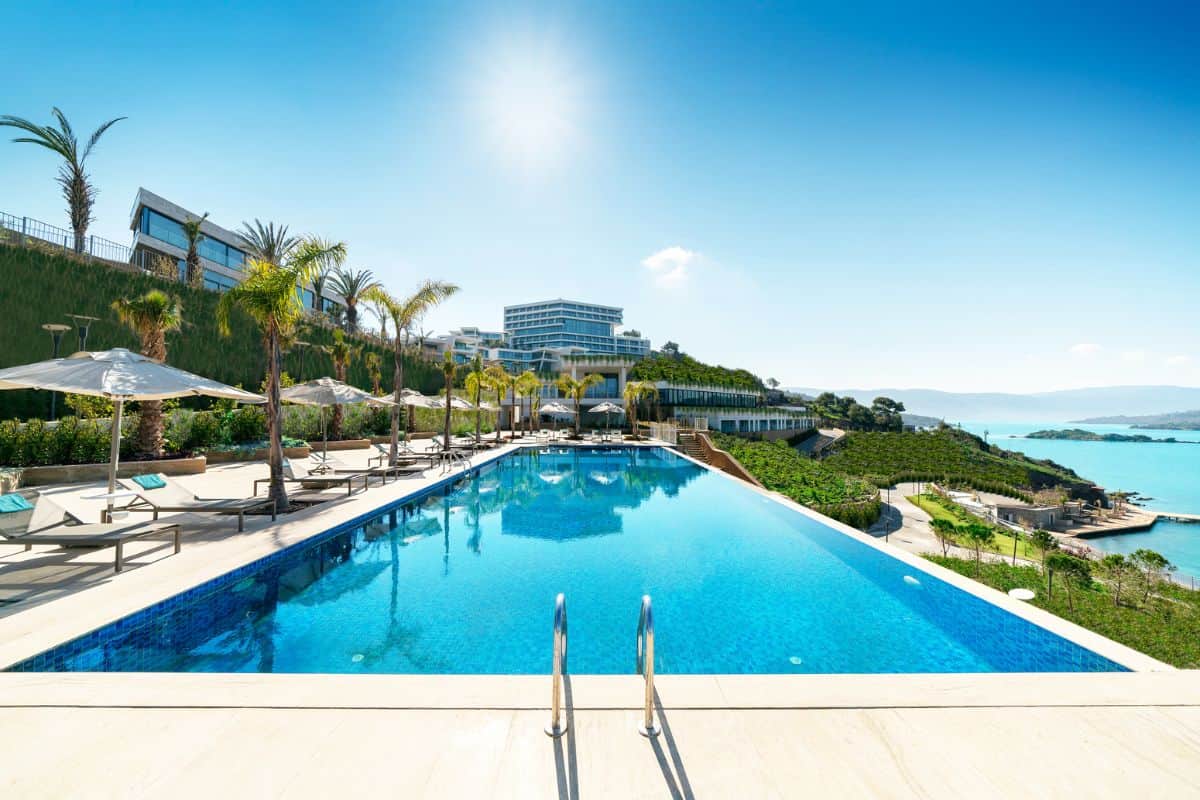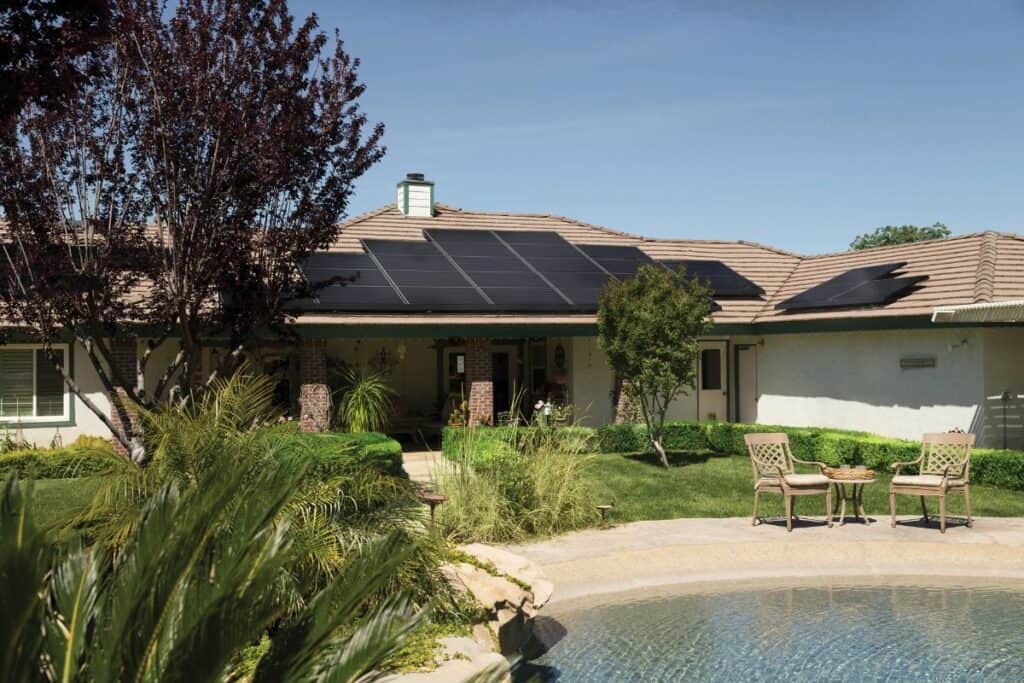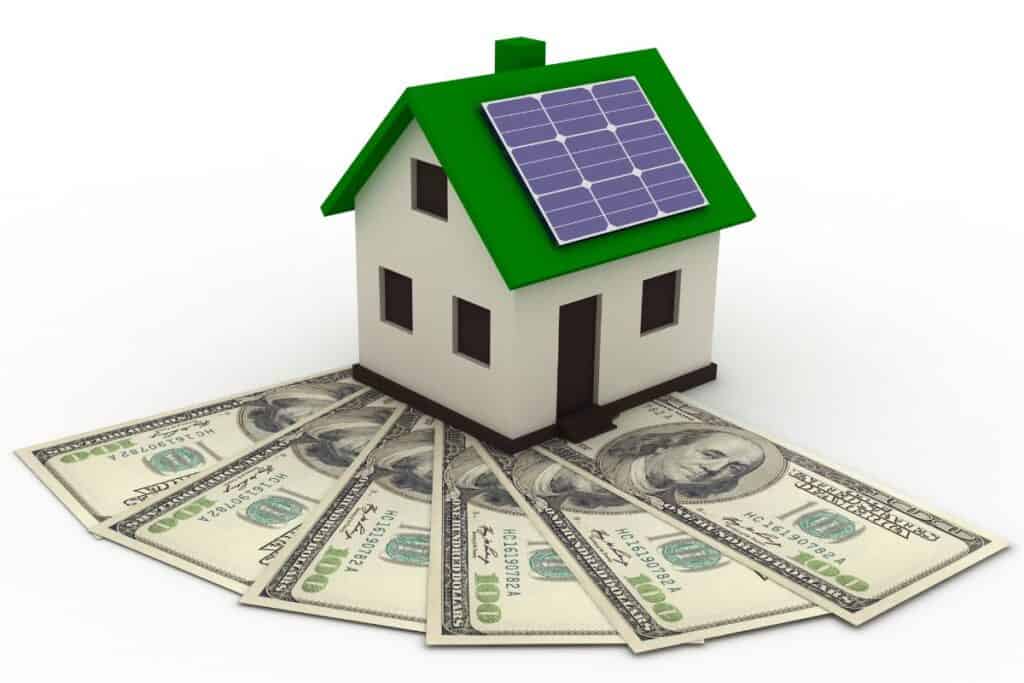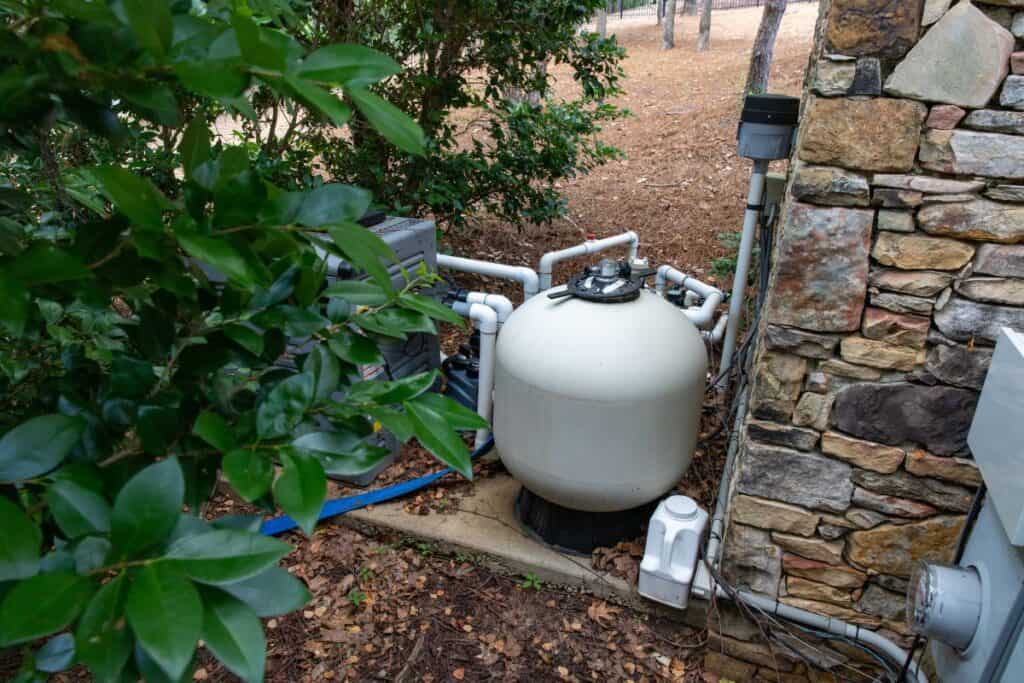Have you ever wondered if it’s possible to use solar energy to run your pool pump? Let’s dive right into this question and find out how you can swim in eco-friendly waters.
Yes, it is possible to use solar energy to power your pool pump. The number of solar panels required to power a pool pump depends on several factors. These include the size of the pump, the number of hours it runs daily, and the amount of sunlight the panels receive.
This green solution not only reduces your carbon footprint but can also lead to significant savings on energy bills over time.
Solar power, with its limitless and renewable nature, is increasingly harnessed for a wide variety of applications, one of which is to run pool pumps.

Using solar energy to power your pool pump is an environmentally friendly and cost-effective method, especially given the considerable amount of energy traditional pool pumps consume.
The heart of such a setup is a solar-powered pool pump, which operates on energy drawn from solar panels.
When sunlight hits the panels, it’s converted into direct current (DC) electricity, which powers the pump. To ensure seamless operation even on cloudy days or at night, batteries can be used to store excess power generated during sunny periods. (More on that later in this article)
Another component to consider is the pool pump itself.
Which solar pool pump is right for you?
There are pool pumps specifically designed for solar power, which are highly efficient and require less energy than conventional pumps.
Solar pool pumps are also typically DC, in contrast to the alternating current (AC) pumps typically found in residential applications.
While DC pumps are more efficient, if you prefer to use an AC pump, an inverter will be needed to convert the DC power from the solar panels.
Using solar power to run your pool pump is not just eco-friendly but also cost-effective in the long run. After the initial investment in the solar setup, the operational costs are minimal.
Given that a pool pump is a significant energy user in many households, the savings can be substantial over time.
However, before embarking on this eco-friendly initiative, it’s crucial to be aware of the local regulations governing solar installations.
Certain areas may require permits or have specific rules regarding the placement and installation of solar panels.
Safety is also paramount.
Solar installations should be performed by a certified professional to ensure they are set up correctly and safely.
Incorrectly installed solar panels can lead to reduced performance or even pose safety risks.
Let’s now dig into how many solar panels it takes to power a pool pump.
How many solar panels would I need to power my pool pump?
Wondering how many solar panels you’d need to power your pool pump? It’s not a one-size-fits-all answer. Several factors come into play, such as the pump’s power rating, your pool’s size, and your local climate.
The number of solar panels needed to run a pool pump depends largely on the pump’s power rating, the duration it operates each day, and the solar irradiance in your location. To start, you need to determine how much energy your pool pump consumes. This is usually indicated in watts or horsepower (HP) on the pump’s nameplate.
A typical pool pump has a power rating between 500 to 2,500 watts.
If we take an example of a pool pump rated at 1,500 watts that operates for 5 hours a day, it would consume 7,500 watt-hours or 7.5 kilowatt-hours (kWh) daily.

Now let’s consider the solar panels…
The real numbers
A typical residential solar panel produces around 300 watts in full sunshine.
However, several factors, such as the angle of the solar panel, local climate, and time of year, can impact the actual energy output.
A more realistic estimate might be around 5 hours of ‘peak’ sunshine per day on average.
If we take the above figures as an example, here’s how you’d calculate the number of solar panels needed:
- Calculate your pool pump’s daily energy consumption: 1,500 watts x 5 hours = 7,500 watt-hours or 7.5 kWh.
- Estimate the daily energy output of one solar panel: 300 watts x 5 hours = 1,500 watt-hours or 1.5 kWh.
- Divide the pump’s daily energy consumption by the panel’s daily output: 7.5 kWh ÷ 1.5 kWh = 5.
In this scenario, you’d need approximately 5 solar panels to power your pool pump.
However, it’s important to note that this is a simplified calculation. For a more accurate assessment, it would be best to consult with a solar installation professional who can take into account other factors like seasonal variations in sunshine, solar panel orientation, and potential shading issues.
Moreover, it would be a good idea to add a few more panels to the calculation to account for cloudy days, the efficiency of the solar inverter, and other potential power losses in the system.
Including a battery storage system in your setup could also help store excess power for use during periods of low sunlight.
Solar-Powered Pool Pumps: Performance During Nighttime and Cloudy Conditions
Concerned about how your solar-powered pool pump would perform at night or during cloudy weather?
The simple answer is that solar panels, by their nature, need sunlight to generate electricity.
However, this doesn’t mean your pool pump has to stop when the sun isn’t shining.
The solution lies in proper planning and use of technology.
A primary consideration when using solar power is that solar panels generate electricity when they’re exposed to sunlight.
At night or during periods of heavy cloud cover, their output reduces significantly, or in the case of nighttime, it stops entirely.
This reduction could impact the performance of your pool pump if you’re solely relying on the live energy generated by your solar panels.
However, that doesn’t mean that you can’t use solar power to run your pool pump at night or during cloudy weather.
The solar pool pump alternatives
There are solutions available, namely, battery storage systems and hybrid solar-grid systems, to keep your pump operating even when your panels are not producing energy.
A battery storage system is used to store excess energy generated by the solar panels during the day.

This stored energy can then be used to power the pool pump during the night or cloudy periods when the panels can’t produce enough energy.
This method ensures a constant supply of power to your pool pump, making it a convenient solution for uninterrupted operation.
On the other hand, a hybrid solar-grid system works by using solar power as the primary energy source and grid power as a backup.
In this setup, when the solar panels can’t generate enough power, the system automatically switches to grid power, ensuring a continuous power supply for your pool pump.
However, both solutions come with their own set of considerations. Installing a battery storage system means additional costs for purchasing and maintaining the batteries.
Plus, batteries have a certain lifespan, after which they need to be replaced.
Meanwhile, with a hybrid solar-grid system, you’d still be reliant on the grid and would incur electricity costs during periods of low solar output.
Is it possible to use a battery backup system for a solar-powered pool pump?
Wondering if you can ensure your solar-powered pool pump runs without interruption, even when the sun isn’t shining? A battery backup system could be the solution you’re seeking.
With a battery backup, you can store surplus energy produced during the day for use during the night or during periods of low solar output. Let’s explore this concept in more detail.
In essence, a battery backup system stores the excess solar power generated by your solar panels. Instead of this power being sent back to the grid or wasted, it’s conserved for later use.
This stored energy can then power your pool pump (or other connected appliances) when the solar panels aren’t producing enough electricity, such as during the night or on particularly cloudy days.
If your goal is to have your pool pump operate primarily or entirely on solar power, a battery backup system can be a crucial addition to your setup.
The risk of NOT having a battery backup
Without it, you might find yourself needing to draw from the grid during non-peak solar production hours, potentially increasing your energy bill and negating some of the benefits of your solar system.
The type and size of the battery backup system you’d need will depend on several factors.
These include the size and power needs of your pool pump, how many hours a day you want to run the pump, and your local weather patterns.
You would want a system that can store enough power to keep your pump running during the longest likely period of low solar output.
To give a basic example, if your pool pump requires 1kWh of energy to run for an hour, and you want to be able to run it for 8 hours overnight, you’d need a battery system with at least 8kWh of storage capacity.
However, for a more comprehensive buffer, you may want to consider a system with a higher capacity.
Bear in mind, though, that adding a battery backup system to your solar panel setup will increase your initial costs.
Yet, in the long run, it could lead to greater energy independence and potentially higher savings. It’s also important to note that battery technology is advancing rapidly, with many new products offering longer lifespans, higher capacities, and lower costs.
In summary, a battery backup system is a viable and increasingly popular option for those wanting to maximize the effectiveness of a solar-powered pool pump.
As always, conducting a thorough cost-benefit analysis based on your specific situation is crucial when considering this kind of investment.

Energy Bill Savings with a Solar-Powered Pool Pump: A Practical Example
You might be wondering how much you could potentially save on your energy bill by using a solar-powered pool pump?
It’s a crucial question for many homeowners, as a pool pump is often a significant energy consumer. By switching to solar power, you could indeed see substantial savings on your electricity bills. Let’s delve into a practical example to give you a better idea of the potential savings.
Consider a typical pool pump running for eight hours a day, which, according to the U.S. Department of Energy, consumes around 2,000 kWh per year. If the average cost per kWh is $0.12, then you would be spending approximately $240 annually to run your pool pump on grid power.
Now, if you switch to a solar-powered pool pump, your solar panels’ initial cost is an important factor to consider.
For this example, let’s assume you spent $2,000 on a solar panel system to run your pool pump.
Here, we’re not considering any available incentives or rebates, which could significantly reduce your out-of-pocket costs.
Solar pool pumps: The REAL Numbers
In this scenario, your solar-powered pool pump would pay for itself in energy savings after roughly eight years ($2,000 divided by $240 annual savings).
After this payback period, you’d essentially be running your pool pump for free, leading to significant long-term savings.
Additionally, if your solar panel system produces more energy than your pool pump needs, you could potentially use that excess energy to power other parts of your home or even sell it back to the grid, depending on your local energy provider’s policies.
This situation could lead to even more savings on your overall electricity bill.
Also, note that solar panels usually come with a warranty of 25 years, and many continue to produce a substantial amount of their initial output well beyond that period.
This long lifespan means you could be enjoying free or reduced-cost pool pump operation for many years after the system has paid for itself.
The key takeaway is that a solar-powered pool pump can potentially lead to substantial savings on your energy bill over the long term.
However, the exact amount of savings can vary depending on many factors, such as your local electricity rates, the cost of your solar panel system, and the amount of sunlight your panels receive.
Therefore, it’s crucial to conduct a thorough cost-benefit analysis based on your specific situation before making the switch.

Solar-Powered vs. Traditional Pool Pumps: Comparing Efficiency and Reliability
If you’re anything like me you’re probably wondering, “Can a solar-powered pool pump really match up to a traditional one in terms of efficiency and reliability?”
This is a valid question, especially since the use of solar energy for such purposes is still somewhat of a new concept for many.
Let’s take a deeper look into this comparison:
Solar-powered pool pumps are remarkably efficient, primarily because they utilize free, renewable energy from the sun. These pumps eliminate the monthly energy costs associated with traditional electric pool pumps, and they’re often designed with energy efficiency in mind to make the most of the solar energy they receive.
On the flip side, traditional pool pumps, though reliable, are generally less energy-efficient. They consume a significant amount of electricity, which can lead to high utility bills.
Plus, they rely on grid electricity, the generation of which often involves the burning of fossil fuels – a major contributor to greenhouse gas emissions.
When it comes to reliability, both solar-powered and traditional pool pumps have their strengths and weaknesses.
How long to pool pumps last?
A well-maintained traditional pump can run reliably for many years, provided there are no power outages. However, a major advantage of solar-powered pumps is that they’re not affected by blackouts or power supply issues, as they operate independently of the grid.
Nevertheless, solar-powered pool pumps’ reliability is closely tied to weather conditions.
On a sunny day, they can operate efficiently. Performance however may drop on cloudy days or during the winter months when daylight hours are shorter.
That said, as we discussed earlier, the addition of a battery backup system can mitigate these challenges, allowing for consistent operation even when sunlight is scarce.
It’s important to mention that solar pool pumps typically have fewer moving parts and operate at lower speeds compared to traditional pumps.
This can lead to less wear and tear, potentially increasing the lifespan of the pump and reducing maintenance requirements.
In conclusion, while solar-powered pool pumps may have a higher initial cost, their operational costs are virtually zero, and they can offer substantial savings over time.
They’re a sustainable, energy-efficient alternative to traditional pool pumps, capable of offering reliable service, especially when paired with a battery backup system.
As with any significant investment, it’s best to consider your specific needs, budget, and local climate when deciding between a solar-powered and traditional pool pump.
